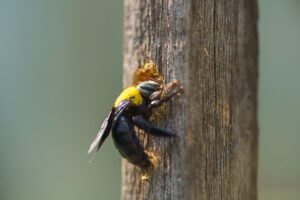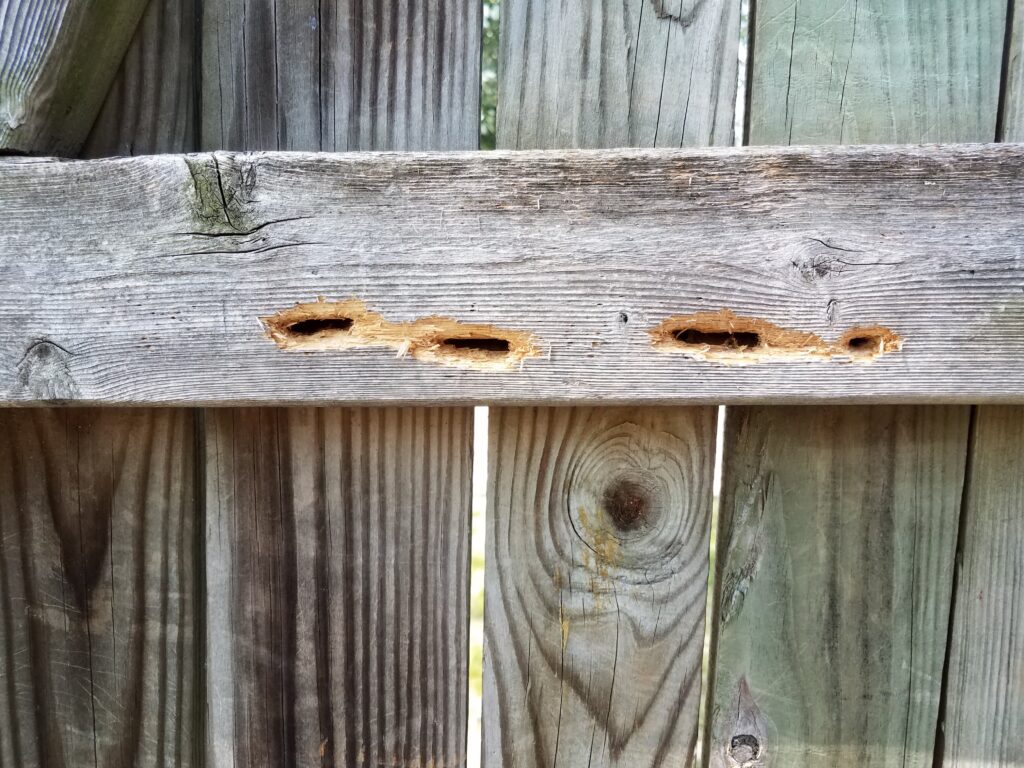Why Carpenter Bees Love Your Home
It's no secret that carpenter bees have a penchant for wood, and they may find your home to be an enticing target. The soft, untreated wood commonly used in eaves, decks, fences, and wooden structures can attract these buzzing pests. Carpenter bees often seek shelter in the warmth and protection provided by the hollowed-out tunnels they create within wooden surfaces, making your home an ideal nesting ground.
Tips to Carpenter Bee-Proof Your Home
While it may seem like an uphill battle, there are several playful yet effective measures you can take to deter carpenter bees from settling in and causing damage to your property:
- Plug Their Entry Points: Inspect your home for potential entry points, such as cracks or holes in wooden structures. Use high-quality wood putty or caulk to seal these gaps and prevent carpenter bees from gaining access.
- Paint It Beautiful: Carpenter bees tend to avoid painted or stained wood surfaces. Apply a fresh coat of paint or stain to exposed wood surfaces, acting as a protective barrier that discourages them from drilling into the wood.
- Swap Soft Woods for Hard Ones: When possible, replace softwood with hardwood alternatives. Carpenter bees prefer softwoods like pine and cedar, but they are less attracted to hardwoods such as oak or teak. Opting for these less appealing options can help minimize carpenter bee activity.
- Hang Some Swinging Spheres: Install decorative hanging spheres made of plastic or glass near wooden structures. The movement and reflective surfaces will confuse and deter carpenter bees, making them think twice before approaching your home.
- Bee-Friendly Repellents: Utilize natural bee-repellent solutions like citrus oils, almond oil, or tea tree oil. These scents are known to repel carpenter bees and can be applied to wooden surfaces around your home.
How to Get Rid of Carpenter Bees
While prevention is key, you may still find yourself dealing with persistent carpenter bees. Here are a few playful methods to help you evict these buzzing tenants:
- Create Some Noise: Carpenter bees are averse to loud sounds and vibrations. Use a portable speaker or radio to play some upbeat tunes near the infested areas, or even better, have an impromptu dance party! The vibrations and noise will make them think twice about sticking around.
- Blow Them Away: Use a handheld electric leaf blower to blow air into the entrance holes. The forceful gusts will disorient the bees and disrupt their nests, encouraging them to seek refuge elsewhere.
- Bee-Trap Bonanza: Set up carpenter bee traps around your property to catch these pesky insects. These traps can be made using simple materials such as empty plastic bottles, wood blocks, and some enticing bait. Remember to relocate captured bees far away from your home.
Carpenter Bee Treatments
Treating for carpenter bees typically involves a combination of preventive measures and targeted treatment methods. Here are some steps to effectively treat for carpenter bees:
- Identify the Nesting Sites: Inspect your property to locate the nesting sites of carpenter bees. Look for round entry holes in wooden surfaces, such as eaves, decks, or fences.
- Dust Insecticides: Apply suitable insecticidal dust, specifically labeled for carpenter bees, into the entry holes. Use a duster to distribute the dust deep into the tunnels, ensuring it reaches the bees inside.
- Seal Entry Points: After treating the nests, seal the entry holes with wood putty or caulk to prevent future infestations. Make sure to wait for a day or two to ensure all bees have been eliminated before sealing the holes.
- Ongoing Prevention: Take preventive measures, such as painting or staining exposed wood surfaces, using bee-repellent sprays or oils, and maintaining regular inspections to address any new signs of carpenter bee activity.
It's important to note that treating for carpenter bees can be challenging, and it may be best to consult with a professional pest control company like My Pest Pros for expert assistance. They have the knowledge, experience, and appropriate tools to effectively treat and prevent carpenter bee infestations. Call My Pest Pros for Expert Help: If your carpenter bee problem persists or becomes overwhelming, it's time to bring in the experts. Schedule your treatment today!

